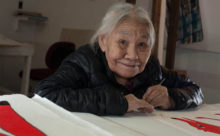Kenojuak Ashevak Obituary NY Times
January 12, 2013
Kenojuak Ashevak, a once-nomadic artist from Canada’s Arctic regions whose prints and drawings helped introduce Inuit art to much of the world, died on Tuesday at her home in Cape Dorset on West Baffin Island in the northern territory of Nunavut. She was 85. The cause was lung cancer, The Canadian Press news agency reported. Kenojuak (pronounced ken-OH-jew-ack), as she was universally known, is probably best remembered for “The Enchanted Owl,” a 1960 print showing an owl with wildly exaggerated feathers and a piercing stare. It became one of Canada’s most famous works of art, appearing on a Canadian stamp in 1970 commemorating the centennial of the Northwest Territories.
Like many Inuit, Kenojuak, who developed her art from the embroidery that she learned as a child, lived in one camp after another in eastern Canada’s far north well into the 1950s. She and her first husband, Johnniebo Ashevak, also an artist, eventually settled in Cape Dorset on Baffin Island so that their children could go to school. There she became part of a group of artists receiving guidance from the Canadian government and the Hudson’s Bay Company, which hoped to develop arts and crafts in the village. The effort was led by James A. Houston, a Toronto artist and writer who had studied printmaking in Japan. The government had named him area administrator for West Baffin Island and charged him with fostering the production of art to provide an income to the Inuit after their fur trade had declined.
In 1959, prints from the region were sold at a Hudson’s Bay Company department store in Winnipeg, Manitoba, in what would become an annual presentation of works. Kenojuak contributed new work until 2012.
Her renown grew after the release in the 1960s of “Kenojuak,” a film produced by the National Film Board of Canada and nominated for an Academy Award for best short documentary. Commissions followed, and Kenojuak, who spoke only Inuktitut, was invited to travel widely for exhibitions of Inuit art in Germany, the Netherlands, South Korea, Seattle and Ottawa, among other places. She also collaborated on a mural that was hung in the Canadian Pavilion at Expo ’70 in Osaka, Japan. In 1981 her art and life were the focus of a limited edition book, “Graphic Arts of the Inuit: Kenojuak.” Kenojuak moved from stone printing into other techniques and eventually added sculpture and stained glass to her work, all in a bold graphic style that favored images of birds.
With Mr. Houston’s help, the Cape Dorset artists founded what is now known as the West Baffin Eskimo Co-operative to manage their print making and market their work. Kenojuak “was very important to the group’s success,” said Christine Lalonde, the associate curator of indigenous art at the National Gallery of Canada. “She also had an enormous influence on the generations that followed her in Cape Dorset.”
Kenojuak — whether she had a surname at birth is not clear; she later took her first husband’s — was born on Oct. 3, 1927, in a camp about 90 miles east of Cape Dorset on Baffin Island. Her first husband died in 1972. Two subsequent marriages, to Itigajuaqujaku Pii and Joanasie Igiju, also ended with her husbands’ deaths. A family member said Kenojuak is survived by six children, 37 grandchildren and 21 great-grandchildren. William B. Ritchie, the studio manager for the cooperative, said that the broad popularity of Kenojuak’s work did not escape the notice of her Inuit peers. “A lot of the other artists embellished their work to look like her’s,” he said. During the last months of her life, he said, Kenojuak produced a series of four-by-six-foot drawings from her bed.
